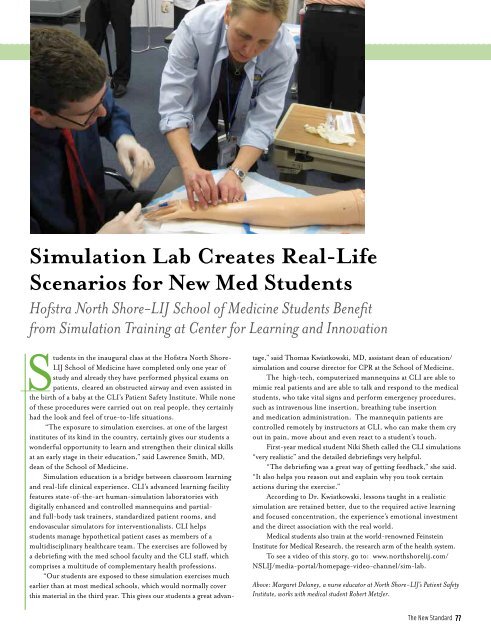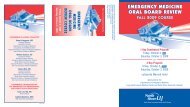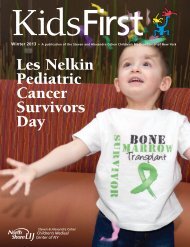Support for Soldiers and Veterans You Gotta Have Heart The Joy of ...
Support for Soldiers and Veterans You Gotta Have Heart The Joy of ...
Support for Soldiers and Veterans You Gotta Have Heart The Joy of ...
Create successful ePaper yourself
Turn your PDF publications into a flip-book with our unique Google optimized e-Paper software.
Simulation Lab Creates Real-Life<br />
Scenarios <strong>for</strong> New Med Students<br />
H<strong>of</strong>stra North Shore-LIJ School <strong>of</strong> Medicine Students Benefit<br />
from Simulation Training at Center <strong>for</strong> Learning <strong>and</strong> Innovation<br />
Students in the inaugural class at the H<strong>of</strong>stra North Shore-<br />
LIJ School <strong>of</strong> Medicine have completed only one year <strong>of</strong><br />
study <strong>and</strong> already they have per<strong>for</strong>med physical exams on<br />
patients, cleared an obstructed airway <strong>and</strong> even assisted in<br />
the birth <strong>of</strong> a baby at the CLI’s Patient Safety Institute. While none<br />
<strong>of</strong> these procedures were carried out on real people, they certainly<br />
had the look <strong>and</strong> feel <strong>of</strong> true-to-life situations.<br />
“<strong>The</strong> exposure to simulation exercises, at one <strong>of</strong> the largest<br />
institutes <strong>of</strong> its kind in the country, certainly gives our students a<br />
wonderful opportunity to learn <strong>and</strong> strengthen their clinical skills<br />
at an early stage in their education,” said Lawrence Smith, MD,<br />
dean <strong>of</strong> the School <strong>of</strong> Medicine.<br />
Simulation education is a bridge between classroom learning<br />
<strong>and</strong> real-life clinical experience. CLI’s advanced learning facility<br />
features state-<strong>of</strong>-the-art human-simulation laboratories with<br />
digitally enhanced <strong>and</strong> controlled mannequins <strong>and</strong> partial-<br />
<strong>and</strong> full-body task trainers, st<strong>and</strong>ardized patient rooms, <strong>and</strong><br />
endovascular simulators <strong>for</strong> interventionalists. CLI helps<br />
students manage hypothetical patient cases as members <strong>of</strong> a<br />
multidisciplinary healthcare team. <strong>The</strong> exercises are followed by<br />
a debriefing with the med school faculty <strong>and</strong> the CLI staff, which<br />
comprises a multitude <strong>of</strong> complementary health pr<strong>of</strong>essions.<br />
“Our students are exposed to these simulation exercises much<br />
earlier than at most medical schools, which would normally cover<br />
this material in the third year. This gives our students a great advan-<br />
tage,” said Thomas Kwiatkowski, MD, assistant dean <strong>of</strong> education/<br />
simulation <strong>and</strong> course director <strong>for</strong> CPR at the School <strong>of</strong> Medicine.<br />
<strong>The</strong> high-tech, computerized mannequins at CLI are able to<br />
mimic real patients <strong>and</strong> are able to talk <strong>and</strong> respond to the medical<br />
students, who take vital signs <strong>and</strong> per<strong>for</strong>m emergency procedures,<br />
such as intravenous line insertion, breathing tube insertion<br />
<strong>and</strong> medication administration. <strong>The</strong> mannequin patients are<br />
controlled remotely by instructors at CLI, who can make them cry<br />
out in pain, move about <strong>and</strong> even react to a student’s touch.<br />
First-year medical student Niki Sheth called the CLI simulations<br />
“very realistic” <strong>and</strong> the detailed debriefings very helpful.<br />
“<strong>The</strong> debriefing was a great way <strong>of</strong> getting feedback,” she said.<br />
“It also helps you reason out <strong>and</strong> explain why you took certain<br />
actions during the exercise.”<br />
According to Dr. Kwiatkowski, lessons taught in a realistic<br />
simulation are retained better, due to the required active learning<br />
<strong>and</strong> focused concentration, the experience’s emotional investment<br />
<strong>and</strong> the direct association with the real world.<br />
Medical students also train at the world-renowned Feinstein<br />
Institute <strong>for</strong> Medical Research, the research arm <strong>of</strong> the health system.<br />
To see a video <strong>of</strong> this story, go to: www.northshorelij.com/<br />
NSLIJ/media-portal/homepage-video-channel/sim-lab.<br />
Above: Margaret Delaney, a nurse educator at North Shore-LIJ’s Patient Safety<br />
Institute, works with medical student Robert Metzler.<br />
<strong>The</strong> New St<strong>and</strong>ard 77




